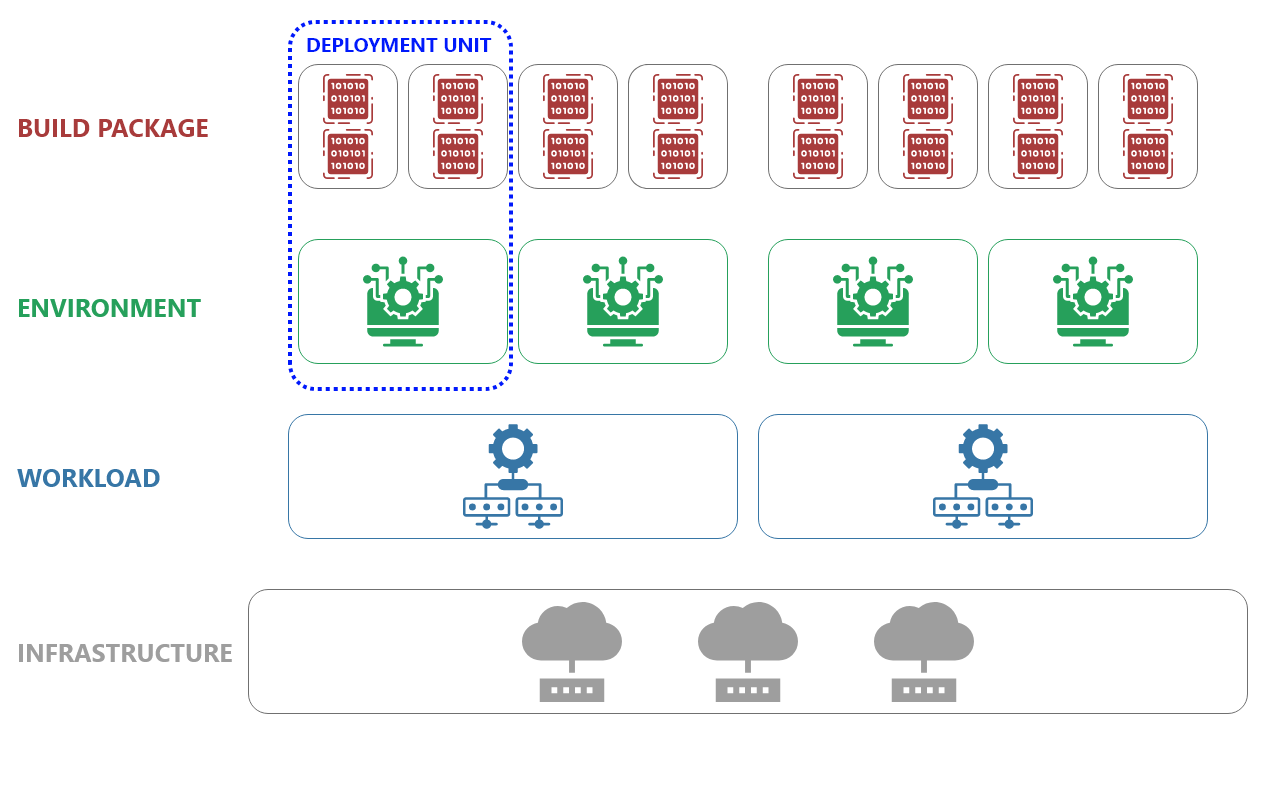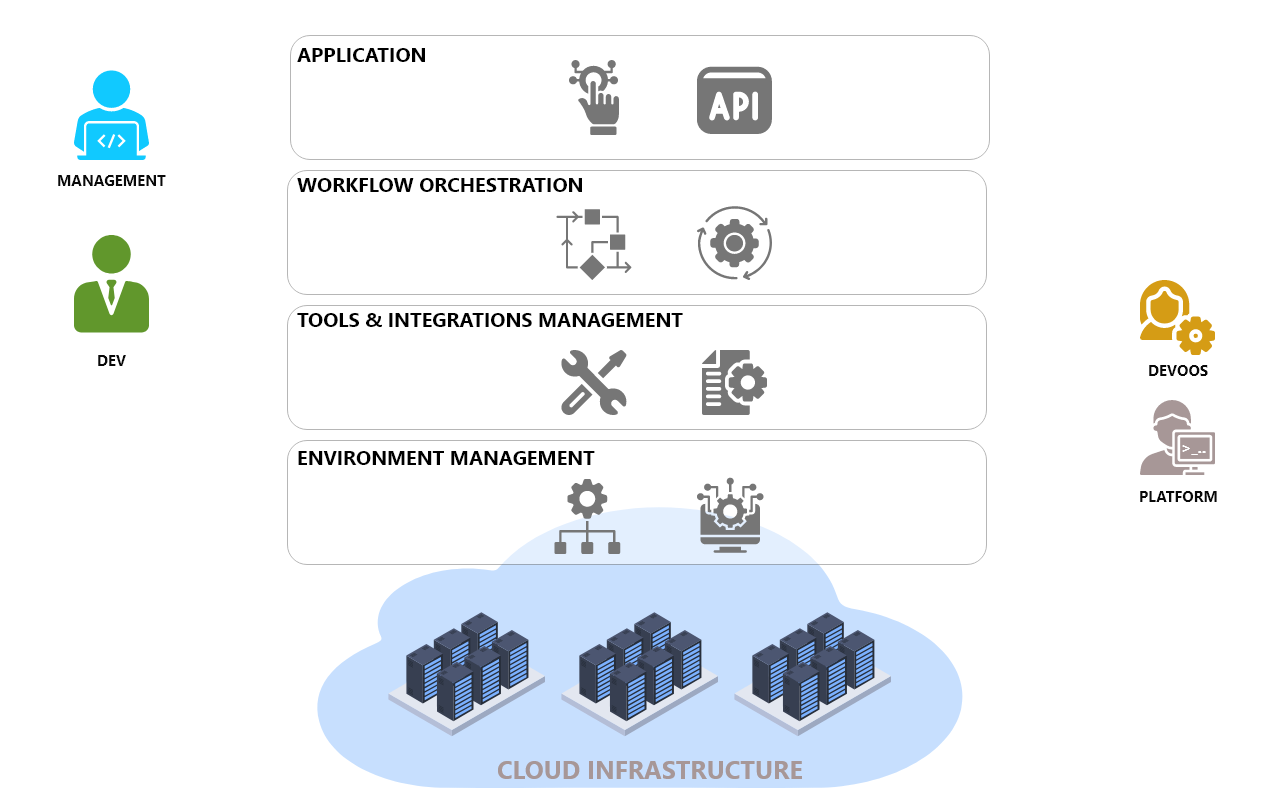In today's software development landscape, cloud deployment is central to every phase of development lifecycle. Everything happens over the cloud, from writing code to testing and further integrations to release. To ensure a consistent cloud deployment throughout the project, organizations face many challenges related to efficiency, scalability, and team collaboration. As applications' complexity grows, so does the need for streamlined and standardized development practices.
Enter Internal Developer Platform (IDP) —a powerful solution designed to address the unique demands of modern software engineering. In this blog post, we'll delve into the core concepts of IDP, exploring its needs and critical technical specifications to help you uncover the virtues of internal developer platforms in revolutionizing software development practices, and providing organizations with the tools to thrive in the complex landscape of cloud-deployed applications.
What is an Internal Developer Platform?
An Internal Developer Platform (IDP) incorporates a series of tools integrated into centrally hosted software to manage the developmental lifecycle of software. Essentially, the IDP is software that eases developers' software development burdens. Its main objective is to manage the operational chores associated with cloud architectures and distributed development teams via a unified control plane to manage the cloud environment, toolchain, and services required to build and deploy applications seamlessly.
IDP achieves this unification through three core principles of standardization, systematization and servitization.
Standardization of deployment unit
A deployment unit is a package encapsulating the binaries, configurations, and dependencies that represent the runtime environment of a software application deployed on the cloud infrastructure.
Some widely used deployment units in cloud computing include containers, virtual machines, and serverless functions. Additionally, there are custom deployment units which combine the basic units in various ways, such as:
- Kubernetes cluster: A Kubernetes cluster is a custom deployment unit that combines multiple containers and orchestrates their management across multiple nodes. Such deployment units are used to deploy scalable and resilient application workloads.
- API gateway: An API gateway is a custom deployment unit that serves as the entry point for client applications to access backend services and resources. This is typically used to deploy service interfaces for SaaS applications.
- Data pipeline: A data pipeline defines a custom data traversal path and processing steps across various stages within an application. It is a special deployment unit mainly used for computationally heavy applications.

Deployment Unit
An IDP standardizes the specification and definition for all deployment units required to host and operate an application on the cloud. This ensures streamlined and predictable provisioning of the underlying runtime environment and infrastructure allocation.
Systematization of tools and integrations
Any software development project relies on many tools to translate the source code into an executable form. These include compilers, transpilers, linkers, and various other tools used for minification, obfuscation, and packaging the executable software into bundles to be encapsulated within deployment units. The development teams also interact with various external systems, such as version control, issue tracking, and security audit services.
The IDP is responsible for maintaining a repository of such tools and integrations for the project. However, beyond just acting as a repository, the IDP also sets up automated workflows using the relevant tools and services. Each such workflow encompasses a set of steps that represents a significant task towards furthering the software development lifecycle. Examples include PR submission and merging, build, continuous integration (CI), continuous deployment (CD), regression testing, and security compliance audits.
Therefore, IDP plays a governing role in building a collection of automated workflows from the ground up to streamline all DevOps activities across all project phases, from development to integration, staging, and production deployment.
Servitization of developer and DevOps workflows
Finally, IDP provides self-service capabilities for development teams to execute the workflows. This is accomplished by exposing the workflows as services that can be triggered via CLI, API, or a web UI.
The result is a streamlined software development process and enhanced developer productivity, where developers do not have to worry about the nuances of workflow execution. Behind the scenes, the IDP orchestrates everything from building and packaging the software, installing the deployment units, setting up the runtime environment, provisioning the workloads, and allocating the infrastructure.
The IDPs also offer a dashboard to facilitate easy access and centralized monitoring. It is a single source of truth where all development teams can congregate to track the project's progress.
The Need for Internal Developer Platforms
But what is the compelling need for internal developer platforms? The answer lies in a few emerging trends in today's software developmental landscape.
- Intricate nature of cloud deployment: Cloud-deployed applications have become increasingly complex. With the shift towards microservices, containerization, and serverless computing, the once-linear path of control flow within a single program has now become a labyrinth of interconnected services, each requiring careful orchestration and management.
- Overlap in team responsibilities: Apart from the development teams, DevOps and platform teams also play a significant role in deployment. Working in silos, these teams often cross into each other’s domain leading to inconsistencies in the development process.
- Security and Compliance Issues: The security of software applications depends not just on the code but also on the tools and various external platform dependencies. Without a governing layer, many loopholes are likely to crop up due to buggy tool versions or improper configuration, impacting quality and time to market.
To better understand the need for IDP, let’s examine a before-and-after scenario through the lens of the three principles of IDP.
Header | Before Using IDP | After Using IDP |
|---|---|---|
Standardization | Due to the lack of a central knowledge base, developers use different nonstandard runtime environments with inconsistent dependencies that do not comply with the software's actual deployment environment. | Developers always have access to a well-defined deployment unit that is spawned based on a standardized set of templates, libraries, and external dependencies for building and deploying software in a consistent manner. |
Systematization | Developers heavily rely on DevOps for software delivery. If the DevOps maturity level is low, then automations related to continuous integration, deployment, monitoring, and management may not be streamlined, which results in frequent manual interventions, leading to intermittent quality issues anywhere between code commit and production release. | Through a comprehensive onboarding process, developers can access pre-built automations, which covers all checks and balances across the CI and CD pipeline. These automations provide detailed reports on development progress, ongoing issues, and any red flags related to quality or security. |
Servitization | Developers frequently approach the DevOps and platform teams with ad-hoc requests to allocate infrastructure, run sys admin chores, and perform process automation. | With a single click, developers can access all processes and automation, ranging from spawning a deployment unit and running automated tests to code deployment under a strict set of compliances. |
Before and After Usage Scenarios for IDP
Architecture of Internal Developer Platform
Internal Developer Platform is more of a concept rather than a standard. Therefore, the internal architecture is subject to the proprietary implementation of each IDP vendor. However, considering the three principles and facilitation of inter-team coordination between development, DevOps and platform teams, we can organize the reference architecture of IDP into the following four layers.

Internal Developer Platform Reference Architecture
- Layer 1 (Environment Management): This layer manages the templates and configurations of the various deployment units. It acts as a liaison point for the platform team that maintains the infrastructure components, such as servers, VMs, storage, and network elements, needed to spawn cloud workloads for running the deployment units.
- Layer 2 (Tools & Integrations Management): This layer consists of a repository of tools and services used in the project to write, test, integrate, and deploy code. Its chief responsibilities include managing all the binaries, images, configurations, and data for executing these tools within standalone build environments. More importantly, this layer tracks the versions and manages updates for the tools to maintain complete compatibility with the software under development.
- Layer 3 (Workflow Orchestration): This layer contains the business logic to automate every foreseeable workflow. Examples include initiating a build, performing static analysis on the code, or triggering a regression test. Each workflow is defined as a golden path, a well-defined set of steps to achieve a goal, and is packaged as a service capsule with supported toolchain integrations that can be triggered independently.
- Layer 4 (Application): This layer acts as a control plane for invoking the IDP services. This is the self-service interface for developers to trigger the automated processes to move the developmental phases toward final production deployment incrementally. It also commands the lower layers to manage the deployment configurations, toolchain execution and gather data for every operation triggered. Yet another essential aspect of this layer is facilitating access control to ensure secure and authorized access to the IDP.
The IDP also includes a few common modules. These cut across all layers to monitor application performance and infrastructure health and facilitate communication, collaboration, and knowledge sharing among teams. IDPs also have a management layer to facilitate project management and report generation.
Choosing the Right IDP for Your Project: Five Key Specifications
To choose the best Internal developer platforms for your project, here are the five key technical specifications to consider.
1: Deployment Unit Requirements
The definition of a deployment unit plays an important role since it has an indirect impact on the team productivity and cost of the cloud infrastructure.
Considering modern cloud applications, there are three main types of deployment:
- Cloud-native microservices application: In this case, Kubernetes is the de-facto platform. Therefore, a Kubernetes cluster becomes the default deployment unit.
- Monolithic application: In this case, the application is deployed as a set of containers running within an underlying container management platform or a bunch of VMs.
- Serverless PaaS application: In this case, the application is deployed in a proprietary serverless environment of a cloud service provider, like AWS Lambda.
So, the first step in choosing an IDP is to define the deployment unit so that the IDP can identify, manage, and configure the underlying infrastructure according to your needs.
The IDP should also be able to manage a split or combination of deployment units for different project phases. For example, a cloud-native application works on multiple Kubernetes clusters, but during the development phase, the developers only need a container for verification and unit testing of their code. The IDP must be able to handle these variances in deployment units across project phases.
2: Hybrid Cloud Capabilities
Managing parallel workloads across multiple cloud service providers is always a process overhead. Therefore, choosing an IDP that supports multiple cloud service providers is the next important decision.
This specification also ties back to the deployment unit requirement since one or more cloud service providers provide the infrastructure to run the deployment units.
Considering the management overheads and confusions arising out of managing multiple cloud service providers, the IDP must also facilitate a few additional aspects of hybrid cloud, such as:
- A unified IAM mechanism to manage cloud resources on all the supported cloud service providers.
- Simple interface for managing availability and reliability related configurations like geo-intelligent DNS, load-balancing, and auto-scaling across all cloud service providers.
- Single window for monitoring, observability, and audit across workloads running in all the supported cloud service providers.
3: Supported Integrations
IDP acts as a central entity orchestrating all the workflows between the developers, DevOps, and the platform teams. Integrations are at the core of this capability and allow the IDP to gather data and trigger events on the ancillary systems that are part of the software development project, such as:
- Version control system
- CI/CD system
- Security testing services
- Code review tools
- Monitoring and observability platforms
The interfacing for working with these integrations plays a vital role in IDP. APIs and Web UI are the most common interfaces provided by all IDPs. In addition, a CLI and SDK-based interface offers great potential for flexibility in configuration and automation.
Another critical consideration for integration is the cloud infrastructure. The IDP must support one or more IaC (Infrastructure as Code) tools, such as Terraform, to automate the deployment of your infrastructure.
4: Self-Service Capabilities
Self-service capabilities define the ease with which developers and DevOps can manage their workflows.
For DevOps, the most important consideration is controlling the DevOps cycle via a set of workflows and supporting infrastructure. The IDP facilitates the automation of workflows through a set of rules, triggers, and actions in conjunction with CI/CD and version control systems.
For developers, it is about having the freedom to work with the developmental processes without worrying about manual work or ad hoc infrastructure configurations.
Ultimately, the self-service capabilities of an IDP must be assessed based on the ease of integration and control over the ancillary ecosystem responsible for managing the software development lifecycle.
5: Collaboration features
Finally, IDP is also responsible for promoting a collaborative culture across the various teams involved in software development. Primarily, there are two ways to achieve it:
- Internal collaboration tools: Building social collaboration features within the IDP web UI, including features like report sharing, team messaging, and social interactions.
- External integrations: Integrating with external applications such as issue tracking or productivity apps used by the team.
Finding Your True IDP Match: Criteria for a Successful Transition
In the final analysis, the IDP becomes increasingly essential for companies seeking to streamline their software development processes, foster collaboration, and accelerate innovation. By providing developers with a unified environment for building, testing, deploying, and monitoring applications, these platforms empower teams to work more efficiently and effectively, ultimately driving business success.
Apart from the factors discussed above, when considering the right IDP for your company, it's crucial to evaluate the complexity of your project and the team headcount. While less complex software with a smaller development team may not require all features of a full-fledged IDP, larger organizations with complex development workflows may require more customizations in the IDP tailored to their specific needs. Ultimately, investing in the right IDP can position your company for long-term growth and competitiveness in today's rapidly evolving technology landscape.
If you are looking for a single source of information about Internal Developer Platforms from across the web, check out https://internaldeveloperplatform.org/.


